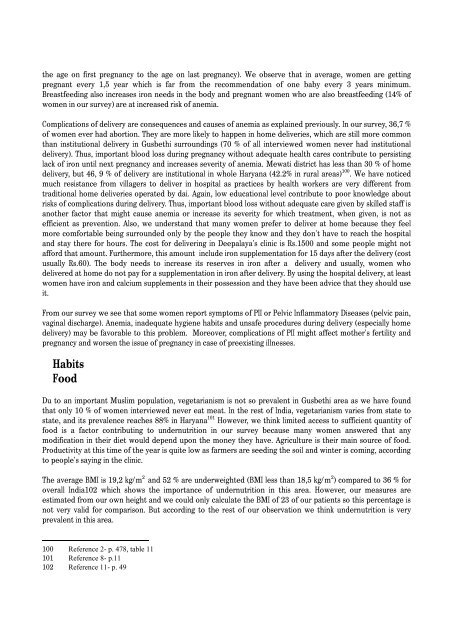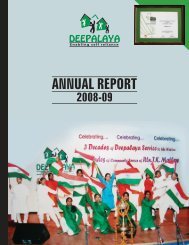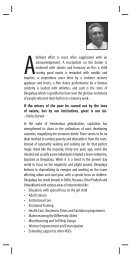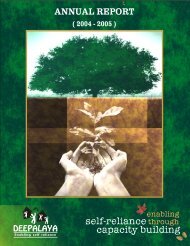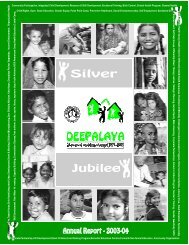Report 2011 - Deepalaya
Report 2011 - Deepalaya
Report 2011 - Deepalaya
You also want an ePaper? Increase the reach of your titles
YUMPU automatically turns print PDFs into web optimized ePapers that Google loves.
the age on first pregnancy to the age on last pregnancy). We observe that in average, women are getting<br />
pregnant every 1,5 year which is far from the recommendation of one baby every 3 years minimum.<br />
Breastfeeding also increases iron needs in the body and pregnant women who are also breastfeeding (14% of<br />
women in our survey) are at increased risk of anemia.<br />
Complications of delivery are consequences and causes of anemia as explained previously. In our survey, 36,7 %<br />
of women ever had abortion. They are more likely to happen in home deliveries, which are still more common<br />
than institutional delivery in Gusbethi surroundings (70 % of all interviewed women never had institutional<br />
delivery). Thus, important blood loss during pregnancy without adequate health cares contribute to persisting<br />
lack of iron until next pregnancy and increases severity of anemia. Mewati district has less than 30 % of home<br />
delivery, but 46, 9 % of delivery are institutional in whole Haryana (42.2% in rural areas) 100 . We have noticed<br />
much resistance from villagers to deliver in hospital as practices by health workers are very different from<br />
traditional home deliveries operated by dai. Again, low educational level contribute to poor knowledge about<br />
risks of complications during delivery. Thus, important blood loss without adequate care given by skilled staff is<br />
another factor that might cause anemia or increase its severity for which treatment, when given, is not as<br />
efficient as prevention. Also, we understand that many women prefer to deliver at home because they feel<br />
more comfortable being surrounded only by the people they know and they don't have to reach the hospital<br />
and stay there for hours. The cost for delivering in <strong>Deepalaya</strong>'s clinic is Rs.1500 and some people might not<br />
afford that amount. Furthermore, this amount include iron supplementation for 15 days after the delivery (cost<br />
usually Rs.60). The body needs to increase its reserves in iron after a delivery and usually, women who<br />
delivered at home do not pay for a supplementation in iron after delivery. By using the hospital delivery, at least<br />
women have iron and calcium supplements in their possession and they have been advice that they should use<br />
it.<br />
From our survey we see that some women report symptoms of PII or Pelvic Inflammatory Diseases (pelvic pain,<br />
vaginal discharge). Anemia, inadequate hygiene habits and unsafe procedures during delivery (especially home<br />
delivery) may be favorable to this problem. Moreover, complications of PII might affect mother's fertility and<br />
pregnancy and worsen the issue of pregnancy in case of preexisting illnesses.<br />
Habits<br />
Food<br />
Du to an important Muslim population, vegetarianism is not so prevalent in Gusbethi area as we have found<br />
that only 10 % of women interviewed never eat meat. In the rest of India, vegetarianism varies from state to<br />
state, and its prevalence reaches 88% in Haryana 101 However, we think limited access to sufficient quantity of<br />
food is a factor contributing to undernutrition in our survey because many women answered that any<br />
modification in their diet would depend upon the money they have. Agriculture is their main source of food.<br />
Productivity at this time of the year is quite low as farmers are seeding the soil and winter is coming, according<br />
to people's saying in the clinic.<br />
The average BMI is 19,2 kg/m 2 and 52 % are underweighted (BMI less than 18,5 kg/m 2 ) compared to 36 % for<br />
overall India102 which shows the importance of undernutrition in this area. However, our measures are<br />
estimated from our own height and we could only calculate the BMI of 23 of our patients so this percentage is<br />
not very valid for comparison. But according to the rest of our observation we think undernutrition is very<br />
prevalent in this area.<br />
100 Reference 2 - p. 478, table 11<br />
101 Reference 8 - p.11<br />
102 Reference 11 - p . 4 9


